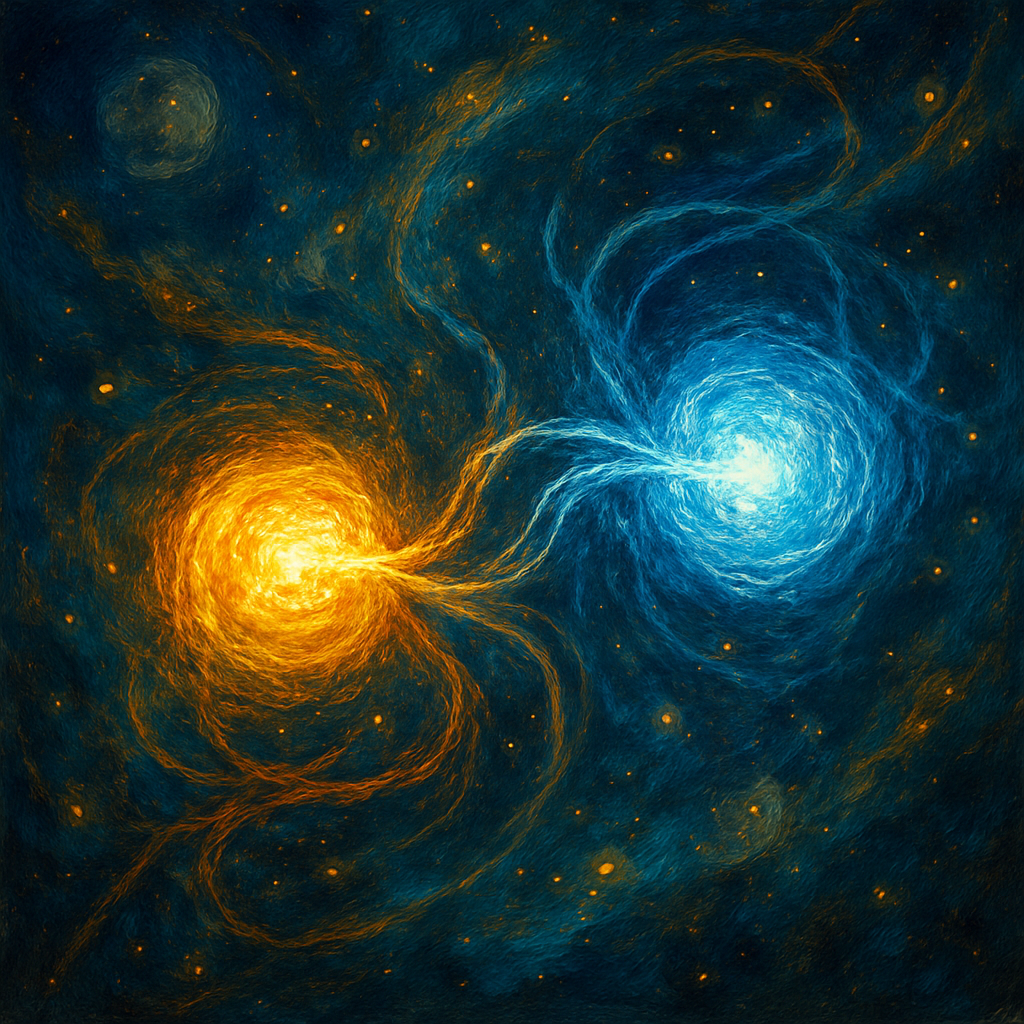Introduction to Quantum Mechanics and Context
The dawn of quantum mechanics in the early 20th century marked a fundamental shift in our understanding of the physical universe. Predating systems in classical physics, quantum mechanics introduces phenomena that defy intuitive logic, leading to revolutionary theories that challenge our perceptions of reality. One of the most astonishing concepts within quantum mechanics is quantum entanglement, a term popularized by Albert Einstein’s disdainful phrasing of ‘spooky action at a distance.’ This phenomenon has mesmerized scientists, philosophers, and curious minds alike, revealing the interconnectedness of particles in ways that seem to transcend the limits of conventional understanding.
Quantum mechanics emerged from the need to explain behaviors observed in particles at the atomic and subatomic levels, behaviors that classical physics couldn’t account for. The foundational theories, introduced by proponents such as Max Planck, Niels Bohr, and Werner Heisenberg, laid the groundwork for our current understanding of quantum mechanics. As researchers delved deeper, the implications of quantum mechanics began to reshape not only physics but also the philosophical landscape of science.
In this article, we will explore quantum entanglement in detail: its definition, historical significance, Einstein’s critique, real-world applications, and the philosophical implications of this astoundingly cryptic phenomena.
Detailed Explanation of Quantum Entanglement
What is Quantum Entanglement?
Quantum entanglement occurs when two or more particles become linked, such that the state of one particle inherently influences or correlates with the state of the other(s), regardless of the distance separating them. This interdependence persists even when the entangled particles are light-years apart, a detail that contributes to its eerie characterization.
Key Principles of Quantum Entanglement
- Superposition: At the heart of quantum mechanics is the principle of superposition, which posits that particles can exist in multiple states simultaneously until measured. For instance, an electron can spin both up and down until observation forces a definitive state.
- Measurement and Collapse: When a measurement is made on one particle in an entangled pair, the other particle’s state is instantaneously determined. This means if we measure one entangled particle and find it spinning up, the other particle will instantly be confirmed to spin down, demonstrating an immediate connection that defies classical limits of communication.
An Example of Quantum Entanglement
Consider the famous thought experiment known as Bell’s theorem, which led to numerous experiments that confirmed the existence of quantum entanglement. Suppose we have two entangled particles—let’s name them Particle A and Particle B. If Particle A is measured, yielding a particular property (a spin direction, for example), Particle B will instantaneously take on the opposite property, no matter how far apart they are.
This peculiar connection has been verified through numerous experiments, most notably by Alain Aspect in the 1980s, where entangled photons were found to exhibit correlated properties over long distances, further solidifying entanglement’s role in quantum mechanics.
Einstein’s Critique and Legacy in Quantum Theory
Albert Einstein’s contributions to physics are unparalleled, yet his stance on quantum mechanics, especially entanglement, was often skeptical. Einstein famously expressed discomfort with entanglement in 1935 when he, along with Boris Podolsky and Nathan Rosen, published a paper detailing what is now known as the EPR Paradox (referring to the initials of the authors). In this paper, they argued that if quantum mechanics is true, then it must involve some form of ‘instantaneous action,’ which Einstein felt violated the principles of locality and determinacy.
Einstein’s Perspective: The EPR Paradox
The essence of the EPR argument rested on the idea that if quantum mechanics could predict the outcomes of measurements without any exchange of information (due to the speed limit imposed by the speed of light), then the theory was inherently incomplete. This laid the groundwork for the philosopher of science to argue against the prevailing interpretations of quantum mechanics. Einstein’s famous quote, “God does not play dice with the universe,” encapsulated his belief that the randomness inherent in quantum mechanics was a superficial phenomenon that could be explained through hidden variables—unseen elements responsible for the apparent randomness.
Legacy in Quantum Theory
Despite his skepticism, Einstein’s critiques led to deeper explorations of quantum mechanics, inspiring subsequent thinkers and experimenting physicists to address the paradoxes he presented. The ongoing debates about the interpretation of quantum mechanics paved the way for advancements in both theoretical and experimental physics. Entanglement is now an established phenomenon that has spurred revolutionary theories and experiments, largely influencing the future of physics and technology.
Applications of Quantum Entanglement in Technology
While quantum entanglement may seem like a strange and remote concept, its applications are quickly moving from theoretical physics into practical technology.
1. Quantum Computing
Quantum entanglement plays a crucial role in the development of quantum computers which utilize qubits—quantum bits that can represent 0 and 1 simultaneously through superposition. Entangled qubits can process vast amounts of data concurrently, making quantum computers exponentially faster than classical computers for certain tasks. This can pave the way for breakthroughs in various domains, such as cryptography, artificial intelligence, and complex system simulations.
2. Quantum Cryptography
The field of quantum cryptography, especially quantum key distribution (QKD), relies heavily on the principles of entanglement. QKD allows the exchange of encryption keys in a fundamentally secure manner. The process utilizes entangled particles to ensure that any attempt to eavesdrop would disturb the quantum states, thereby alerting both communicating parties to the security breach.
3. Quantum Teleportation
Quantum entangled particles have led to experiments in quantum teleportation, a technique to transfer quantum information from one location to another without physical transportation of the particle itself. Though still limited and experimental, this technology presents exciting possibilities for communication within quantum networks.
Conclusions and Philosophical Implications
The concept of quantum entanglement poses numerous philosophical questions regarding the nature of reality, locality, and the interconnectedness of universe. Einstein’s initial concerns have only fostered further inquiry into the foundations of quantum mechanics, but today, scientists accept quantum entanglement as a real and observable phenomenon.
Moreover, as applications of quantum entanglement emerge in technology, we are faced with ethical considerations and questions regarding privacy, security, and the potential disruption to existing industries. As quantum technologies continue to soothe the line between theory and application, they challenge classical notions of information transfer and the nature of reality itself.
To this day, Einstein’s reflections on quantum mechanics continue to resonate, encouraging ongoing dialogue and discovery between philosophy and science. Whether viewed as a foundational principle of nature or an unresolved conundrum, quantum entanglement exemplifies the intricate tapestry of our universe and beckons us to open our minds to figures beyond traditional limitations.
Frequently Asked Questions (FAQ)
What is the main idea behind quantum entanglement?
Quantum entanglement is a phenomenon in quantum physics where two or more particles become interconnected, such that the state of one affects the state of the others instantly, regardless of distance.
How did Einstein respond to quantum entanglement?
Albert Einstein expressed skepticism towards quantum entanglement, famously referring to it as ‘spooky action at a distance’ and arguing that the theory was incomplete, proposing instead that hidden variables must exist to explain the correlations.
What are the real-world applications of quantum entanglement?
Quantum entanglement is being used in various modern technologies, including quantum computing, quantum cryptography, and quantum teleportation, each showing promise for transforming industries.
Is quantum entanglement fully understood?
While quantum entanglement is well-established and observable, the underlying mechanisms and implications continue to prompt philosophical and scientific exploration, leaving room for further inquiry and discovery.
What impact does quantum entanglement have on the philosophy of science?
Quantum entanglement challenges conventional notions of locality, determinism, and the interconnectedness of the universe, prompting philosophical discussions that bridge science and metaphysics.


